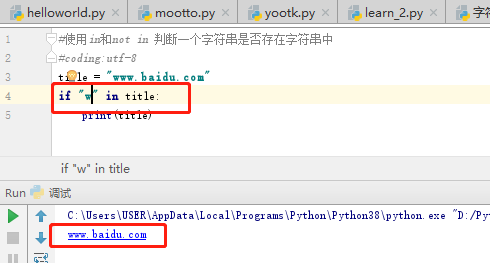元组(tuple)是与列表类似的线性数据结构,与列表结构所不同的是,元组定义中的内容不允许被修改及容量的动态扩充。
将列表转换为元组:
#coding:utf-8
numbers =[1,3,5,7,9,11,13,15,]
tuples = tuple(numbers)
print("numbers变量的数据类型:%s" % type(numbers)) #获取列表类型
print("tuples变量的数据类型:%s" % type(tuple)) #获取类型
序列统计函数:
#coding:utf-8 #序列统计函数
numbers =[1,3,5,7,9,] #定义列表信息
print("元素个数:%d" % len(numbers)) #统计序列中个数
print("元素最大值:%d" % max(numbers)) #统计序列中最大值
print("元素最小值:%d" % min(numbers)) #统计序列中最小值
print("元素总和:%d" % sum(numbers)) #统计序列中总和
print(any((True,1,"helsll"))) #判断元组内的结果
print(all((True,None))) #判断元组中的结果

字符串
字符串(str)是python中最为常用的一种数据类型,一个字符串可以理解为由若干个字符组成的序列结构,它可以使用所有操作比如:字符串分片、数据统计操作等
字符串切片获取:
#coding:utf-8
title = "明天会更好:www.teday.com"
sub_url = title[6:] #字符串切片获取
sub_name = title[:5] #字符串切片
print(sub_url)
print(sub_name)
字符串信息统计:

#coding:utf-8
title = "www.baidu.com"
print("字符串长度:%d" % len(title))
print("最大字符:%c" % max(title))
print("最小字符:%c" % min(title))
使用in和not in去判断一个字符串是否存在字符串中:
#coding:utf-8
title = "www.baidu.com"
if "w" in title:
print(title)
